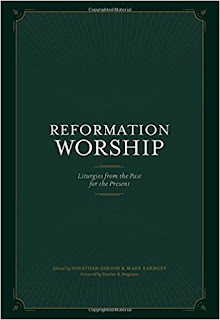"Reformation Worship" ed. by Jonathan Gibson and Mark Earngey. A Review
Reformation Worship: Liturgies from the
Past for the Present
Ed. by Jonathan Gibson and Mark Earngey
New Growth Press
1301 Carolina St., Suite L-101
Greensboro, NC 27401
Greensboro, NC 27401
ISBN: 978-1-948130-21-9; 23 April 2018; $69.99
Many American Presbyterian and
Reformed believers are either out of touch with their Reformation roots, or
have only snippets of information. One area where this is glaringly clear is in
regard to worship, and specifically liturgy. Jonathan Gibson, assistant
professor of Old Testament at Westminster Theological Seminary, and Mark Earngey, doctoral candidate at the
University of Oxford, have accomplish a yoeman’s job in their new 736 page
hardback “Reformation Worship: Liturgies from the past for the Present”. This weighty tome is ideal for liturgists,
worship leaders, pastors, seminary professors, and highly interested parties.
It is a reference work that “aims to recover and reaffirm the significant part
that worship played in the Magisterial Reformation, both for the Reformers and
for their churches” (xxiii).
The volume’s Foreword, penned by Sinclair Ferguson, lays out the benefit of this
work. It gives “impressive testimony to the way the Reformers in various
countries devoted much attention to the subject of worship” (xv). As Ferguson goes on to note, the rediscovery
of the gospel and the reforming of worship were two sides of the same coin! And
so the liturgies spelled out in the book “should stimulate careful thought, and
cause us to ask how we can apply their principles today in a way that echoes
their Trinitarian, Christ-centered, biblically informed content, so that our
worship, in our place and time, will echo the gospel content and rhythm they
exhibit” (xix).
Gibson then pours forth several pages
unpacking the worshipful structure of the biblical story, from the primeval
Eden to the perpetual Eden of the new heavens and new earth. He remarks that since “grace restores nature,
and with it worship, the general structure of worship in Eden remained:
call-response-meal” (8). Earngey makes his own contribution by mapping out the
Reformers’ ideas and principles in fashioning their liturgies. Then both
authors team up to give examples and thoughts to how these historical liturgies
can inform the way we worship. As they noted, the “recovery of the gospel in
the Reformation was ultimately a worship war – a war against the idols, a war
for the pure worship of God” (49). They state firmly, that their work is meant
to be “an irenic plea for the Church (and especially her ministers) to engage
again with the two-millennia-old question: “How then shall we worship?” Through
examination of the Reformation liturgies from the past, there is a wealth of
treasure for the present” (73).
The remainder of the book consists of
looking extensively at twenty-six liturgies from the Reformation; twenty-six!
They begin with Martin Luther and his various orders of worship, and work their
way to the Palatine Church Order and the Middleburg Liturgy. Did I say they
rehearse twenty-six liturgies? It is a full volume! Each chapter begins with a
brief historical sketch of the liturgical craftsman, the immediate environment,
and the responses each received. Then the form of worship is charted in an
easy-to-peruse diagram. And finally, the whole order is presented in a modern
English version translated or updated by the authors. Twenty-six in all! I was
happily exhausted when I finished reading through them! But I was also better
informed and encouraged in how my congregation worships and follows much of
these older patterns.
“Reformation Worship” will inspire
worship leaders who have roots in the Reformation. It has the potential of
interesting those whose traditions are more independent but are finding their
existential rootlessness problematic. Not only will this be a worthwhile volume
to take up and read; but it will likely remain a primo reference work for many
years to come. I highly recommend the work!
Thanks to New Growth Press for
providing, upon my request, the free copy of the book used for this review. The
assessments are mine given without restrictions or requirements (as per Federal
Trade Commission’s 16 CFR, Part 255).
If you would like to obtain a copy, you can go here: Reformation Worship.




Comments